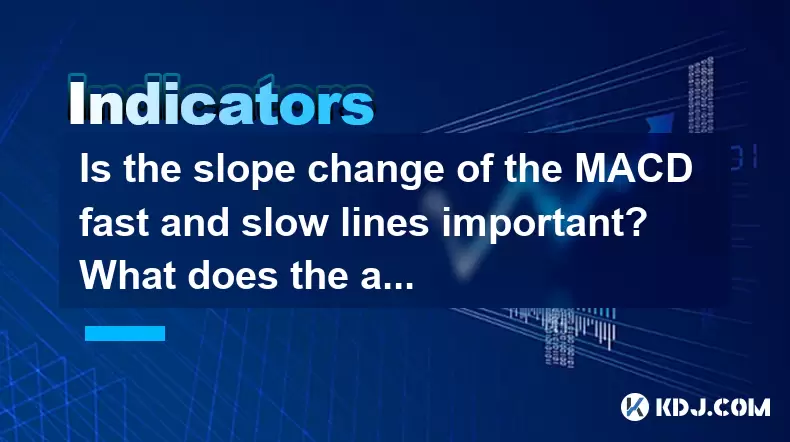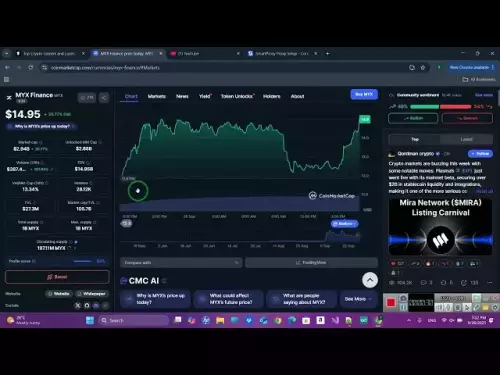-
 bitcoin
bitcoin $109547.008142 USD
0.04% -
 ethereum
ethereum $4011.838726 USD
-0.05% -
 tether
tether $1.000402 USD
-0.01% -
 xrp
xrp $2.798606 USD
0.88% -
 bnb
bnb $970.877944 USD
1.39% -
 solana
solana $202.237275 USD
-0.95% -
 usd-coin
usd-coin $0.999673 USD
0.00% -
 dogecoin
dogecoin $0.229294 USD
-1.15% -
 tron
tron $0.336370 USD
-0.45% -
 cardano
cardano $0.777260 USD
-1.66% -
 hyperliquid
hyperliquid $45.503019 USD
1.73% -
 ethena-usde
ethena-usde $1.000362 USD
0.01% -
 chainlink
chainlink $20.785303 USD
-1.10% -
 avalanche
avalanche $28.755822 USD
-0.11% -
 stellar
stellar $0.358303 USD
-0.48%
Is the slope change of the MACD fast and slow lines important? What does the acceleration or slowing of the slope indicate?
The slope of MACD lines reflects momentum changes; an accelerating slope signals a strengthening trend, while a flattening slope indicates waning momentum.
May 23, 2025 at 03:42 am

The Moving Average Convergence Divergence (MACD) is a popular technical indicator used by cryptocurrency traders to gauge momentum and potential trend changes. The MACD consists of two lines: the MACD line and the signal line. The MACD line is calculated by subtracting the 26-period Exponential Moving Average (EMA) from the 12-period EMA, while the signal line is a 9-period EMA of the MACD line. The slope of these lines can provide valuable insights into market conditions, and understanding the significance of their slope changes is crucial for making informed trading decisions.
Understanding the Slope of the MACD Lines
The slope of the MACD lines reflects the rate of change in the underlying price momentum. When the MACD line is sloping upward, it indicates that the short-term momentum is increasing relative to the long-term momentum, suggesting a bullish trend. Conversely, a downward slope of the MACD line signals a bearish trend, with the short-term momentum decreasing relative to the long-term momentum. The signal line, being a smoother version of the MACD line, helps traders identify potential entry and exit points by smoothing out short-term fluctuations.
Importance of Slope Changes
Changes in the slope of the MACD lines are critical because they can signal shifts in market momentum. A steepening slope of the MACD line indicates an acceleration in the rate of change, suggesting a strengthening trend. For example, if the MACD line is sloping upward and the slope becomes steeper, it implies that the bullish momentum is increasing. On the other hand, a flattening or declining slope suggests a deceleration or reversal in the trend. If the MACD line is sloping upward but the slope starts to flatten, it might indicate that the bullish momentum is waning.
Acceleration of the Slope
The acceleration of the slope in the MACD lines can be a powerful indicator of a strengthening trend. When the MACD line accelerates upward, it signifies that the bullish momentum is gaining strength, potentially leading to a significant price increase. Similarly, an accelerating downward slope of the MACD line indicates that bearish momentum is intensifying, which could result in a substantial price drop. Traders often look for these accelerations to confirm the strength of a trend and to make timely trading decisions.
Slowing of the Slope
A slowing of the slope in the MACD lines can signal a potential reversal or a period of consolidation. When the MACD line starts to flatten after an upward slope, it suggests that the bullish momentum is losing steam, which could lead to a price correction or a trend reversal. Likewise, a flattening of the downward slope indicates that bearish momentum is weakening, potentially leading to a price bounce or a shift to a bullish trend. Traders use these slowdowns to adjust their positions, either by taking profits or preparing for a possible trend change.
Interpreting Slope Changes in Trading
To effectively interpret slope changes in the MACD lines, traders need to combine this information with other technical indicators and market analysis. Here are some practical steps to consider:
- Monitor the Slope: Regularly observe the slope of the MACD and signal lines to gauge the strength and direction of the trend.
- Look for Divergences: Check for divergences between the MACD line and the price action. A bullish divergence occurs when the price makes a lower low, but the MACD line makes a higher low, suggesting a potential reversal. Conversely, a bearish divergence happens when the price makes a higher high, but the MACD line makes a lower high, indicating a possible downward reversal.
- Use Confirmation: Confirm slope changes with other indicators such as the Relative Strength Index (RSI) or the Moving Average (MA) to increase the reliability of the signals.
- Set Stop-Loss and Take-Profit Levels: Based on the slope changes and other confirmations, set appropriate stop-loss and take-profit levels to manage risk and lock in profits.
Practical Examples of Slope Changes
To illustrate the importance of slope changes, consider the following scenarios:
- Scenario 1: The MACD line has been sloping upward for several weeks, indicating a strong bullish trend. Suddenly, the slope starts to steepen, suggesting an acceleration in bullish momentum. Traders might interpret this as a signal to enter long positions or to add to existing positions, expecting further price increases.
- Scenario 2: After a period of upward movement, the MACD line begins to flatten, indicating a slowdown in bullish momentum. Traders might see this as a warning sign and decide to take profits or tighten their stop-loss levels to protect against a potential reversal.
- Scenario 3: The MACD line has been sloping downward, reflecting a bearish trend. The slope then accelerates, signaling an increase in bearish momentum. Traders might use this as a confirmation to enter short positions or to increase their exposure to the bearish trend.
Conclusion
Understanding the slope changes of the MACD fast and slow lines is essential for cryptocurrency traders looking to capitalize on momentum shifts. The acceleration or slowing of the slope provides valuable insights into the strength and potential direction of trends. By closely monitoring these changes and combining them with other technical analysis tools, traders can make more informed decisions and improve their trading performance.
Frequently Asked Questions
Q1: How can I differentiate between a temporary slope change and a more significant trend shift in the MACD lines?A1: To differentiate between a temporary slope change and a more significant trend shift, consider the following:
- Duration: Temporary slope changes tend to be short-lived, while significant trend shifts persist over a longer period.
- Confirmation: Look for confirmation from other indicators such as the RSI, volume, and price action. If multiple indicators align with the slope change, it's more likely to be a significant trend shift.
- Magnitude: A more significant change in the slope, especially if it's accompanied by a divergence between the MACD line and the price, suggests a more substantial trend shift.
A2: Yes, the slope changes in the MACD lines can be used for both short-term and long-term trading strategies:
- Short-term Trading: Traders can use short-term slope changes to identify quick entry and exit points. For example, a sudden steepening of the slope might signal a short-term momentum shift, prompting traders to enter or exit positions quickly.
- Long-term Trading: For long-term strategies, traders can focus on more sustained slope changes that indicate broader trend shifts. A gradual change in the slope over weeks or months can help traders adjust their long-term positions accordingly.
A3: The effectiveness of analyzing MACD slope changes can vary depending on the time frame:
- Short-term Time Frames (1-minute to 1-hour charts): These are useful for day traders and scalpers looking to capitalize on quick momentum shifts. However, the signals can be noisy and require careful confirmation.
- Medium-term Time Frames (1-hour to 4-hour charts): These are suitable for swing traders who aim to capture medium-term trends. The slope changes are less noisy and can provide more reliable signals.
- Long-term Time Frames (daily to weekly charts): These are ideal for position traders and investors focusing on long-term trends. The slope changes in these time frames can help identify significant trend shifts and major market movements.
A4: To avoid false signals when trading based on MACD slope changes, consider the following strategies:
- Use Multiple Time Frames: Analyze the MACD slope changes across different time frames to confirm the signals. A slope change that appears on multiple time frames is more likely to be valid.
- Combine with Other Indicators: Use other technical indicators like the RSI, Bollinger Bands, or volume to confirm the slope changes. If multiple indicators align, the signal is more reliable.
- Wait for Confirmation: Instead of acting immediately on a slope change, wait for additional confirmation, such as a crossover of the MACD line and the signal line or a divergence between the MACD and the price.
- Set Appropriate Risk Management: Always use stop-loss orders to limit potential losses from false signals. Adjust your position sizes and risk levels based on the strength and reliability of the signals.
Disclaimer:info@kdj.com
The information provided is not trading advice. kdj.com does not assume any responsibility for any investments made based on the information provided in this article. Cryptocurrencies are highly volatile and it is highly recommended that you invest with caution after thorough research!
If you believe that the content used on this website infringes your copyright, please contact us immediately (info@kdj.com) and we will delete it promptly.
- Ripple, Shiba Inu, and Digitap: The Crypto Landscape in 2025
- 2025-09-28 23:05:12
- Crypto Portfolio Management: Riding the Whale Waves and Finding Gems
- 2025-09-28 22:45:14
- BTC Price Wobbles as Bitcoin ETFs See Inflows, Ethereum ETFs Bleed: What's the Deal?
- 2025-09-28 22:25:17
- DeepSnitch AI: The Meme Coin Alternative with 1000x Potential?
- 2025-09-28 22:45:14
- BlockchainFX, Solana, Dogecoin: Decoding the Crypto Shift
- 2025-09-28 23:05:12
- Crypto's Wild Ride: Dogecoin, AVAX, TRUMP, and the Newcomer MAGACOIN FINANCE
- 2025-09-28 23:10:01
Related knowledge

What is a tower bottom candlestick pattern? Does it have a high success rate?
Sep 22,2025 at 07:18am
Tower Bottom Candlestick Pattern Explained1. The tower bottom candlestick pattern is a reversal formation that typically appears at the end of a downt...

What is a black hole pattern in the MACD indicator? Is it a cause for concern?
Sep 21,2025 at 06:54pm
Bitcoin's Role in Decentralized Finance1. Bitcoin remains the cornerstone of decentralized finance, serving as a benchmark for value and security acro...

How can I use the psychological line (PSY) to determine market sentiment?
Sep 17,2025 at 02:19pm
Understanding the Psychological Line (PSY) in Cryptocurrency TradingThe Psychological Line, commonly referred to as PSY, is a momentum oscillator used...

How can I determine if a double top pattern has officially formed?
Sep 21,2025 at 03:18am
Understanding the Structure of a Double Top Pattern1. A double top pattern consists of two distinct peaks that reach approximately the same price leve...

What is the Golden Valley pattern on the moving average? Is it better than the Silver Valley pattern?
Sep 21,2025 at 02:54pm
Understanding the Golden Valley Pattern in Moving Averages1. The Golden Valley pattern is a technical formation observed in cryptocurrency price chart...

What does a death cross of the RSI in the strong zone (above 50) mean?
Sep 17,2025 at 10:54pm
Understanding the Death Cross in RSI Context1. The term 'death cross' is traditionally associated with moving averages, where a short-term average cro...

What is a tower bottom candlestick pattern? Does it have a high success rate?
Sep 22,2025 at 07:18am
Tower Bottom Candlestick Pattern Explained1. The tower bottom candlestick pattern is a reversal formation that typically appears at the end of a downt...

What is a black hole pattern in the MACD indicator? Is it a cause for concern?
Sep 21,2025 at 06:54pm
Bitcoin's Role in Decentralized Finance1. Bitcoin remains the cornerstone of decentralized finance, serving as a benchmark for value and security acro...

How can I use the psychological line (PSY) to determine market sentiment?
Sep 17,2025 at 02:19pm
Understanding the Psychological Line (PSY) in Cryptocurrency TradingThe Psychological Line, commonly referred to as PSY, is a momentum oscillator used...

How can I determine if a double top pattern has officially formed?
Sep 21,2025 at 03:18am
Understanding the Structure of a Double Top Pattern1. A double top pattern consists of two distinct peaks that reach approximately the same price leve...

What is the Golden Valley pattern on the moving average? Is it better than the Silver Valley pattern?
Sep 21,2025 at 02:54pm
Understanding the Golden Valley Pattern in Moving Averages1. The Golden Valley pattern is a technical formation observed in cryptocurrency price chart...

What does a death cross of the RSI in the strong zone (above 50) mean?
Sep 17,2025 at 10:54pm
Understanding the Death Cross in RSI Context1. The term 'death cross' is traditionally associated with moving averages, where a short-term average cro...
See all articles









































































